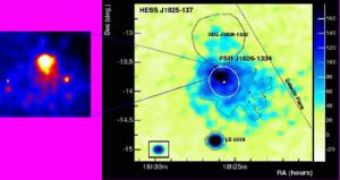A mixed French-South African research team has made the first catalog of a new kind of gamma-ray source, a dozen clouds of "relic" radiation from dead stars that offer data about the past of those space bodies.
The work was done using data gathered during 2004 and 2005 by the High Energy Stereoscopic System (H.E.S.S.), a multinational collaboration that employs a group of four 40-foot telescopes located in Namibia, Africa.
The high-energy gamma rays are expelled from regions near pulsars (rapidly spinning ultra-dense space objects appeared after a supernova explosion of a star) but not directly by the pulsars themselves. Pulsars were known to emit a particle "wind", but the scale of gamma-ray emission surprised the astronomers: many pulsars are wrapped in a gamma-ray glow many dozens of light years across.
These winds, fueled by the pulsar, were proven to induce these very energetic gamma rays.
Pulsars can have a mass 1.4 times bigger than that of the Sun compassed into a sphere only a few miles across and highly powerful magnetic fields, billions and even trillions times higher than the Earth's.
In such a strong magnetic field, electrons are accelerated to the light speed; when an electron slams into a photon (light particle), the photon can collect the energy of the electron and the highly energized photon turns into a super-high-energy gamma ray, with a trillion times more energy than visible light.
The most studied pulsar in the center of the Crab Nebula, generates winds of X-rays (with less energy than gamma rays) but the pulsar investigated by the H.E.S.S. team is far more extended.
The glow of gamma rays detected from the pulsar PSR B1823-13 is roughly 100 light years (one light year is the distance traveled during one year with 186,000 miles or 300,000 km per second in one year) across.
The larger zones of gamma-ray emissions point to the fact that the gamma ray producing electrons have moved further, thus are older and the research of the gamma ray winds depict the history of the pulsar and its magnetic field during the past tens of thousands of years.
"About half of the sources discovered by H.E.S.S. in the central parts of the Galactic Plane are most likely large relic gamma-ray nebulae associated with middle-aged pulsars: these nebulae should then constitute a major component of the very high energy gamma-ray sky. Further observations in radio, X-rays, gamma-rays and detailed studies of these objects should confirm further these results and yield precious insights on the evolution of the pulsars and their nebula including constraints on the magnetic field evolution with time", said Dr. Arache Djannati-Ata?, an astrophysicist from the Astroparticle & Cosmology (APC) laboratory in Paris, France.
Photo credit: APC

 14 DAY TRIAL //
14 DAY TRIAL //